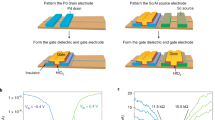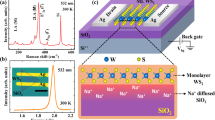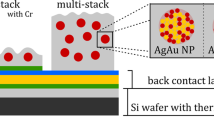Abstract
The demand for increased information storage densities has pushed silicon technology to its limits and led to a focus on research on novel materials and device structures, such as magnetoresistive random access memory1,2,3 and carbon nanotube field-effect transistors4,5,6,7,8,9, for ultra-large-scale integrated memory10. Electromechanical devices are suitable for memory applications because of their excellent ‘ON–OFF’ ratios and fast switching characteristics, but they involve larger cells and more complex fabrication processes than silicon-based arrangements11,12,13. Nanoelectromechanical devices based on carbon nanotubes have been reported previously14,15,16,17, but it is still not possible to control the number and spatial location of nanotubes over large areas with the precision needed for the production of integrated circuits. Here we report a novel nanoelectromechanical switched capacitor structure based on vertically aligned multiwalled carbon nanotubes in which the mechanical movement of a nanotube relative to a carbon nanotube based capacitor defines ‘ON’ and ‘OFF’ states. The carbon nanotubes are grown with controlled dimensions at pre-defined locations on a silicon substrate in a process that could be made compatible with existing silicon technology, and the vertical orientation allows for a significant decrease in cell area over conventional devices. We have written data to the structure and it should be possible to read data with standard dynamic random access memory sensing circuitry. Simulations suggest that the use of high-k dielectrics in the capacitors will increase the capacitance to the levels needed for dynamic random access memory applications.
This is a preview of subscription content, access via your institution
Access options
Subscribe to this journal
Receive 12 print issues and online access
$259.00 per year
only $21.58 per issue
Buy this article
- Purchase on Springer Link
- Instant access to full article PDF
Prices may be subject to local taxes which are calculated during checkout




Similar content being viewed by others
References
Parkin, S. S. P. et al. Exchange-biased magnetic tunnel junctions and application to nonvolatile magnetic random access memory. J. Appl. Phys. 85, 5828–5833 (1999).
Reohr, W. et al. Memories of tomorrow. IEEE Circuits & Devices 18, 17–27 (2002).
Hillebrands, B. & Fassbender, J. Ultrafast magnetic switching. Nature 418, 493–495 (2002).
Tans, S. J., Verschueren, A. R. M. & Dekker, C. Room-temperature transistor based on a single carbon nanotube. Nature 393, 49–52 (1998).
Kong, J., Soh, H. T., Cassell, A. M., Quate, C. F. & Dai, H. Synthesis of individual single-walled carbon nanotubes on patterned silicon wafers. Nature 395, 878–881 (1998).
Martel, R., Schmidt, T., Shea, H. R., Hertel, T. & Avouris, Ph. Single- and multi-wall carbon nanotube field-effect transistors. Appl. Phys. Lett. 73, 2447–2449 (1998)
Fuhrer, M. S., Kim, B. M., Durkop, T. & Brintlinger, T. High-mobility nanotube transistor memory. Nano Lett. 2, 755–759 (2002).
Radosavljevic, M., Freitag, M., Thadani, K. V. & Johnson, A. T. Nonvolatile molecular memory elements based on ambipolar nanotube field effect transistor. Nano Lett. 2, 761–764 (2002).
Javey, A., Guo, J., Wang, Q., Lundstrom, M. & Dai, H. Ballistic carbon nanotube field-effect transistors. Nature 424, 654–657 (2003).
Nakagome, Y., Horiguchi, M., Kawahara, T. & Itoh, K. Review and future prospects of low-voltage RAM circuits. IBM J. Res. Dev. 47, 525–552 (2003).
Petersen, K. E. Micromechanical membrane switches on silicon. IBM J. Res. Dev. 23, 376–385 (1979).
Yao, Z. J., Che, S., Eshelman, S., Denniston, D. & Goldsmith, C. Micromachined low-loss microwave switches. IEEE J. Microelectromech. Syst. 8, 129–134 (1999).
Gou, F. M. et al. Study on low voltage actuated MEMS rf capacitive switches. Sensors and Actuators A 108, 128–133 (2003).
Kim, P. & Lieber, C. M. Nanotube nanotweezer. Science 286, 2148–2150 (1999).
Rueckes, T. et al. Carbon nanotube-based non-volatile random access memory for molecular computing. Science 289, 94–97 (2000).
Dequesnes, M., Rotkin, S. V. & Aluru, N. R. Calculation of pull-in voltages for carbon-nanotube-based nanoelectromechanical switches. Nanotechnology 13, 120–131 (2002).
Badzey, R. L., Zoflagharkhani, G., Gaidarzhy, A. & Mohanty, P. A controllable nanomechanical memory element. Appl. Phys. Lett. 85, 3587–3589 (2004).
Prince, B. Semiconductor Memories 2nd edn, Ch. 6 (Wiley, New York, 1991).
Park, Y. K. et al. Effective capacitance enhancement methods for 90-nm DRAM capacitors. J. Korean Phys. Soc. 44, 112–116 (2004).
Chhowalla, M. et al. Growth processes conditions of vertically aligned carbon nanotubes using plasma enhanced chemical vapor deposition. J. Appl. Phys. 90, 5308–5316 (2001).
Teo, K. B. K. et al. Plasma enhanced chemical vapour deposition carbon nanotubes/nanofibers—how uniform do they grow? Nanotechnology 14, 204–211 (2003).
Jang, J. E. et al. Nanoscale capacitors based on metal–insulator–carbon nanotube–metal structures. Appl. Phys. Lett. 87, 263103 (2005).
Ha, D. et al. Anomalous junction leakage current induced by STI dissociation and its impact on dynamic random access memory devices. IEEE Trans. Electron. Devices 46, 940–946 (1999).
Kim, K., Hwang, C. & Lee, J. G. DRAM technology perspective for gigabit era. IEEE Trans. Electron. Devices 45, 598–608 (1998)
Wilk, G. D., Wallace, R. M. & Anthony, J. M. High-k gate dielectrics: Current status and materials properties considerations. J. Appl. Phys. 89, 5243–5275 (2001).
Zhang, Y. et al. Electric-field-directed growth of aligned single-walled carbon nanotubes. Appl. Phys. Lett. 79, 3155–3157 (2001).
Hoffman, S. et al. Direct growth of aligned carbon nanotube field emitter arrays onto plastic substrates. Appl. Phys. Lett. 83, 4661–4663 (2003).
Roukes, M. L. Nanoelectromechanical systems. In Technical Digest of the 2000 Solid-State Sensor and Actuator Workshop, Hilton Head Isl, SC, 4–8 June 2000 (Transducer Research Foundation, Cleveland, 2000) 〈http://arxiv.org/pdf/condmat/0008187〉.
Author information
Authors and Affiliations
Contributions
J.E.J. was involved in project conception, planning, experimental work and data analysis, S.N.C. in project conception, experimental work and data analysis, Y.J.C., T.B., D.J.K. and J.E. Jung in experimental work, D.G.H. in experimental guidance and direction, J.M.K. in project conception and data analysis, G.A.J.A. in project conception and guidance, data analysis and interpretation.
Correspondence and requests for materials should be addressed to G.A.J.A.
Corresponding author
Rights and permissions
About this article
Cite this article
Jang, J., Cha, S., Choi, Y. et al. Nanoscale memory cell based on a nanoelectromechanical switched capacitor. Nature Nanotech 3, 26–30 (2008). https://doi.org/10.1038/nnano.2007.417
Received:
Accepted:
Published:
Issue Date:
DOI: https://doi.org/10.1038/nnano.2007.417
This article is cited by
-
Nanoscale modeling of an efficient Carbon Nanotube-based RF switch using XG-Boost machine learning algorithm
Microsystem Technologies (2023)
-
Dynamic pull-in and snap-through behavior in micro/nano mechanical memories considering squeeze film damping
Microsystem Technologies (2017)
-
Nonlinear vibration analysis of a microbeam subject to electrostatic force
Acta Mechanica (2017)
-
Dynamic behavior of micro-resonator under alternating current voltage
International Journal of Mechanics and Materials in Design (2017)
-
Vertical, capacitive microelectromechanical switches produced via direct writing of copper wires
Microsystems & Nanoengineering (2016)



